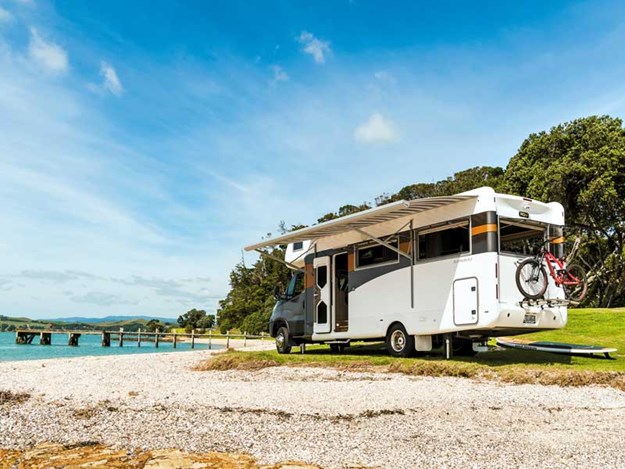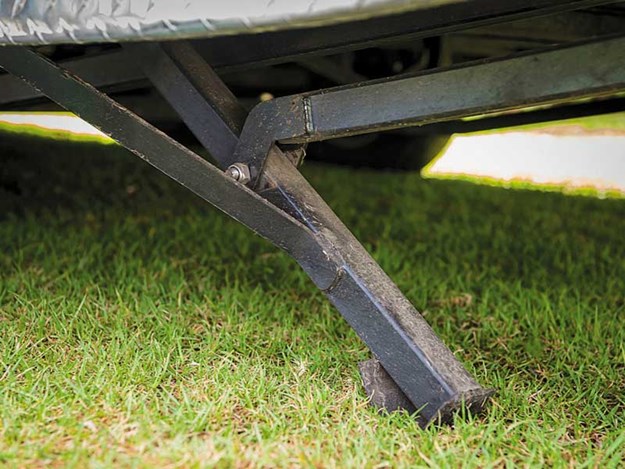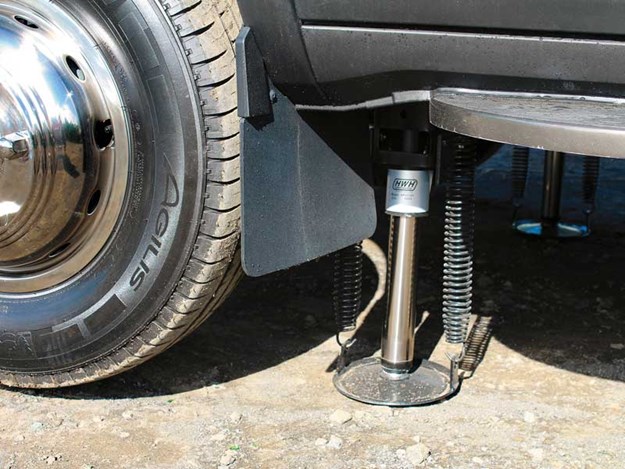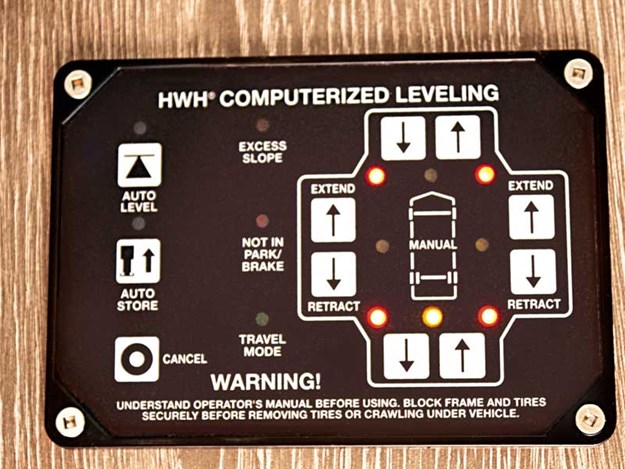Apart from creating a more comfortable living environment, a couple of important systems in the RV work better when the vehicle is level; the fridge and the water drainage.
Most RVs have an absorption fridge running on LPG.
 |
Levellers offer a more stable platform when windy and can be used to tilt the vehicle when draining grey water tanks |
These need to be nearly level, with no more than five degrees of slope, for the refrigeration process to work correctly. And water usually drains better from the kitchen sink, the bathroom hand basin and the shower tray if the RV is parked on a level surface.
Achieving ‘level-heaven’
 |
No need for manual corner steadies when your RV has hydraulic levellers |
To achieve ‘level-heaven’ RVers usually have a selection of chocks and blocks to fine-tune the process when parking up for a while. Levelling using chocks and blocks can be a demanding exercise needing accurate brake and throttle control.
Another way to achieve ‘level-heaven’ is to install levelling jacks. This relatively expensive system has been around for quite a while, but is now more sophisticated and user-friendly than ever. When deployed, levelling jacks offer benefits beyond a level floor, including:
- virtual elimination of floor movement squeaks and rattles when jacked up
- a more stable RV in windy conditionsa stable platform, enabling the satellite dish to stay locked onto target the ability to tilt the vehicle when draining grey water tanks
- an optional way of lifting the RV to change wheels (punctures)
- the ability to use the levelling jacks to lift the RV if ‘stuck in the mud’ so that traction-able material can be placed beneath the wheel(s).
What makes them go?
 |
This simple leveller has a spring return to raise the jack |
RV levelling systems mostly use four hydraulic jacks, mounted on the chassis, as close as possible to each corner of the RV. Usually a single pump drives the four hydraulic jacks, but larger capacity systems may have a separate pump for each jack.
To accommodate different types of vehicles with their different mounting opportunities, manufacturers offer different leg styles; telescopic, swing-down and fixed. Generally speaking, fixed legs suit vehicles with good ground clearance while swing or telescopic jacks suit vehicles with limited mounting space and/or low ground clearance.
The two common control methods
 |
A typical dash-mounted control panel |
There are two common control methods; a dashboard-mounted control panel and/or a hand-held remote. Suppliers may set these up differently but they usually offer basic options like auto-level, front pair, rear pair or individual jacks. The auto levelling procedure is usually completed within 90 seconds of pressing the ‘go’ button.
Obviously, the jacks need to be retracted before driving off. There is usually a light and sound warning if the ignition is turned on while the jacks are down. It is recommended the engine remains running during the levelling procedure to reduce the draw-down on the house battery.
RV levelling quick tips
- Systems that have power lowering (as well as raising) offer better control than those that just open the hydraulic pressure release valve to drop the RV.
- They should be waterproof and able to operate while submerged. Those that don’t require chassis frame drilling, the spare wheel to be relocated, or the exhaust pipe re-routed, will reduce installation costs.
- Those that are partially or totally manufactured from aluminium alloy will be lighter and take up less of your vehicle’s payload.
Taking the plunge
The first step is to determine which leg setup would best suit your RV. Key people to contact are the equipment suppliers and the equipment fitters to establish what is best for your needs.
Note that some suppliers supply only, while others supply and fit. Also bear in mind that larger jack kits can weigh 60kg plus so keep an eye on your payload.
Indicative prices
- A four-jack kit (500kg per jack) costs approx $4200.
- A four-jack kit with four pumps (1925kg per jack) is approx $10,350.
- Installation costs and engineer’s report costs are additional to the kit costs.





